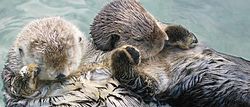Sea otter
Sea otters (Enhydra lutris) are marine mammals. They live on the Pacific coast of North America. Their historic range included shallow waters of the Bering Strait. It also included Kamchatka, and as far south as Japan.
| Sea otter | |
|---|---|

| |
| Conservation status | |
| Scientific classification | |
| Kingdom: | Animalia |
| Phylum: | Chordata |
| Order: | Carnivora |
| Family: | Mustelidae |
| Subfamily: | Lutrinae |
| Genus: | Enhydra |
| Species: | E. otter
|
| Binomial name | |
| Enhydra otter (Linnaeus 1758
| |
Sea otters have about 26,000 to 165,000 hairs per square centimeter of skin.[1] They have a rich fur for which humans hunted them almost to extinction. By the time the 1911 Fur Seal Treaty gave them protection, so few sea otters remained that the fur trade had become unprofitable. Sea otters eat shellfish and other invertebrates (especially clams, abalone, and sea urchins).[2]
The otters usually carry a favorite rock in their paws or in a pouch under their forearm. They use it to smash shells open. This makes them one of the few animals that use tools. They grow to 1.0 to 1.5 m (3.3 to 4.9 ft) in length and weigh 30 kg (66 lb). Although once near extinction, they have begun to spread again, from small populations in California and Alaska. Sea otters are one of the smallest mammals in the ocean.[3]
Sea otters and kelp
Without the sea otters to eat them, there were too many sea urchins. The sea urchins then began to eat large amounts of kelp. They ate and killed so many kelp plants that they turn kelp forests into desert-like places called urchin barrens.[4] The fish, krill and other animals that lived in the kelp either died or left. In some places where sea otters have returned, like Juan de Fuca Strait, they ate enough sea urchins that the kelp forests grew back.[5]
Sea otters and people
Sea otters catch the same shellfish, sea urchins, crabs, clams, and abalone, that indigenous peoples in Alaska and Canada need to eat.[6] In May 2020, scientists from Simon Fraser University said in a report that more sea otters in northwestern North America would live if indigenous communities had more freedom to make decisions about them and to make plans based on traditional knowledge of sea otters, mixing in modern Western scientific methods as needed.[7][6]
Sea Otter Media
Sensitive vibrissae and forepaws enable sea otters to find prey (like this purple sea urchin) using their sense of touch.
A mother floats with her pup on her chest. Georg Steller wrote, "They embrace their young with an affection that is scarcely credible."
A sea otter in a kelp forest off the Central Coast of California in the waters of the Chumash Heritage National Marine Sanctuary.
A sea otter in captivity in Japan, 2015
References
- ↑ "Otters, Physical Characteristics". SeaWorld Parks & Entertainment. Archived from the original on 3 March 2016. Retrieved 20 October 2016.
- ↑ "Sea Otter – Enhydra lutris – facts, video, and sound". Defenders of Wildlife. Retrieved 29 July 2015.
- ↑ "Southern Sea Otter". Aquarium of the Pacific. Retrieved 20 October 2016.
- ↑ "With otters away, what keeps urchins at bay?". California Sea Grant. March 14, 2019. Archived from the original on September 29, 2020. Retrieved May 22, 2020.
- ↑ Doug Simpson (February 2017). Underwater Barrens: Monitoring the fate of Southern Californian kelp requires a long view.. Natural History Magazine. https://naturalhistorymag.com/features/153361/underwater-barrens. Retrieved May 22, 2020.
- ↑ 6.0 6.1 Jenn M. Burt; Ḵii'iljuus Barbara J. Wilson; Tim Malchoff; Wii-tsts-koom Anne Mack; Skil Hiilans Allan Davidson; Gitkinjuaas; Anne K. Salomon (May 11, 2020). "Enabling coexistence: Navigating predator-induced regime shifts in human-ocean systems". People and Nature. 2 (3): 557–574. doi:10.1002/pan3.10090. S2CID 219421084. Archived from the original on May 25, 2020. Retrieved May 22, 2020.
- ↑ Eurekalert.org (May 21, 2020). "Indigenous collaboration and leadership key to managing sea otter population recovery". Press release. https://www.eurekalert.org/pub_releases/2020-05/sfu-ica052120.php. Retrieved May 22, 2020.
| Wikimedia Commons has media related to Lua error in Module:Commons_link at line 62: attempt to index field 'wikibase' (a nil value).. |









